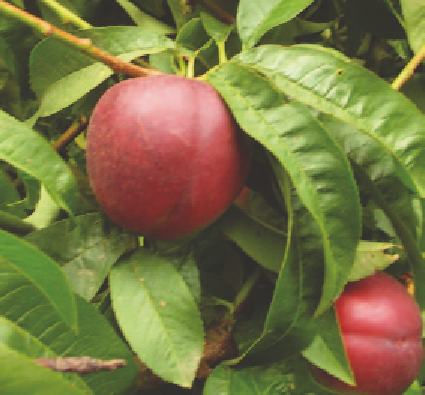Agriculture Reference
In-Depth Information
planting (see pages 17 and 126). There is
little else to be done other than the removal
of dead, diseased or crowded wood. Netting
them when in fruit is usually not viable given
their size but fortunately they are so prolific
that there is more than enough for both
people and birds.
Fruitingwood
Mulberries fruit in the leaf axils of
actively growing shoots and also on spurs
from older wood. As long as the tree is
healthy it should fruit with or without
pruning. Spur development can be
encouraged by shortening back side
growths after fruiting.
Figure 6.24
The delectable nectarine.
Nectarines,peaches,peacharinesand
almonds
Prunuspersica
var.
nectarine
,
P.persica
,
P.dulcis
Peaches, nectarines and almonds are all
pruned in exactly the same manner.
Nectarines are a variety of peach, the major
difference being the lack of fuzz. Almonds,
although a different species, fruits on the
same wood and benefits from the same
treatment. Such delectable fruit needs plenty
of air and sunshine to develop so they are best
trained to an open vase or a fan espalier (see
pages 132-134). In commercial orchards, they
can be trained to a central trunk planted at
an oblique angle with their side branches
trained at a 45° angle from the trunk, much
like a Belgian fence without the initial trunk
(see pages 126 and 133). A bush shape is not
as effective as having a naturally spreading
habit, they tend to turn into an umbrella
shape with the best fruit produced at the top
of the tree rather than within reach of the
Pruningtime
Prune directly after harvest if you need to
prune at all. Some cultivars with
M. rubra
in
their breeding will develop the strange habit
of trying to produce fruit in mid-winter if
they are pruned at any other time.
As for all other mulberries excepting the
dwarf, prune in winter for growth and
summer to restrict growth.
Dwarfmulberries
The dwarf cultivar of
Morus nigra
does need
regular pruning after it has fruited. It is
grown as a shrub with foliage to the ground.
After harvest, cut back the plant by one-third
clearing overcrowded wood as you go. As a
shrub it will be multi-stemmed; cut out one
major branch every few years to renew the
fruiting wood.

